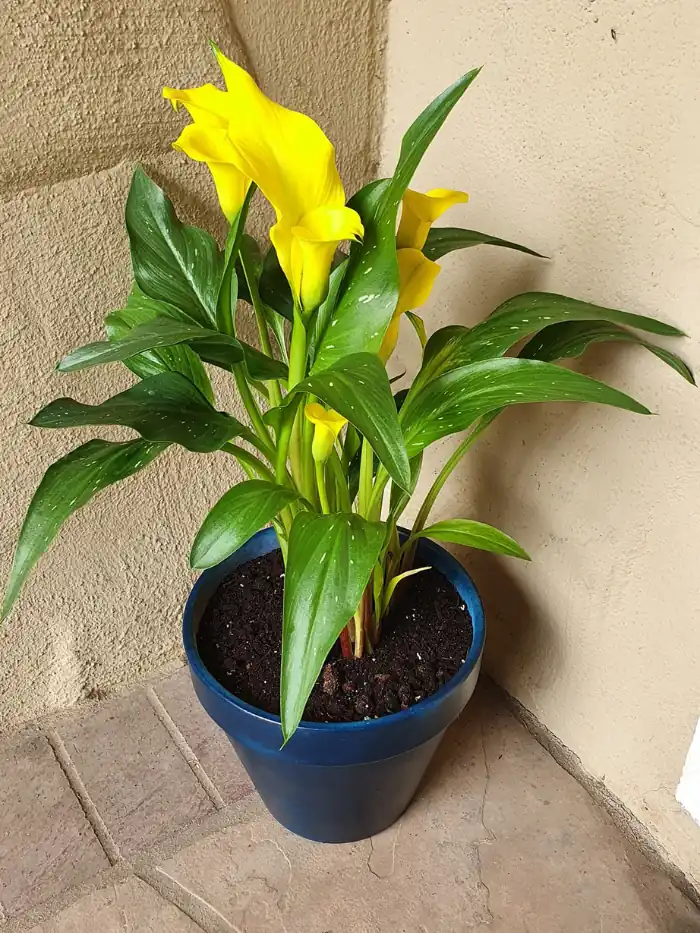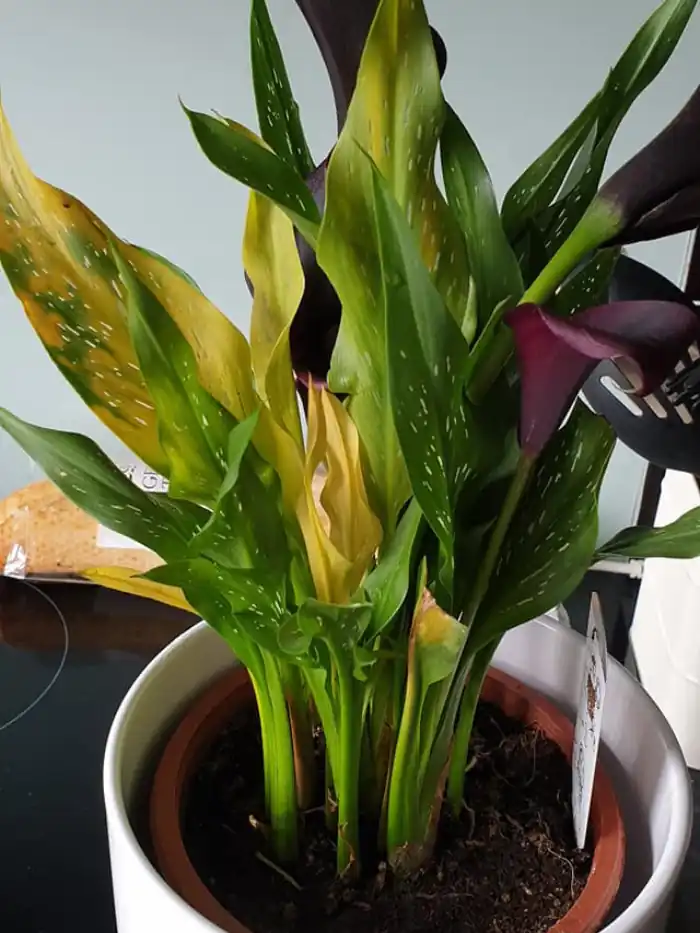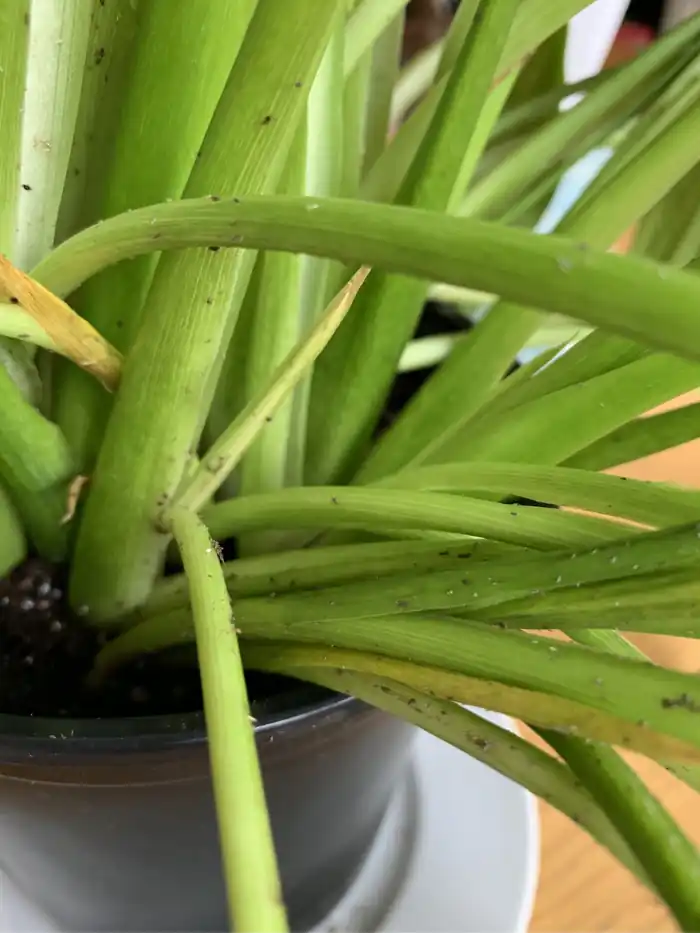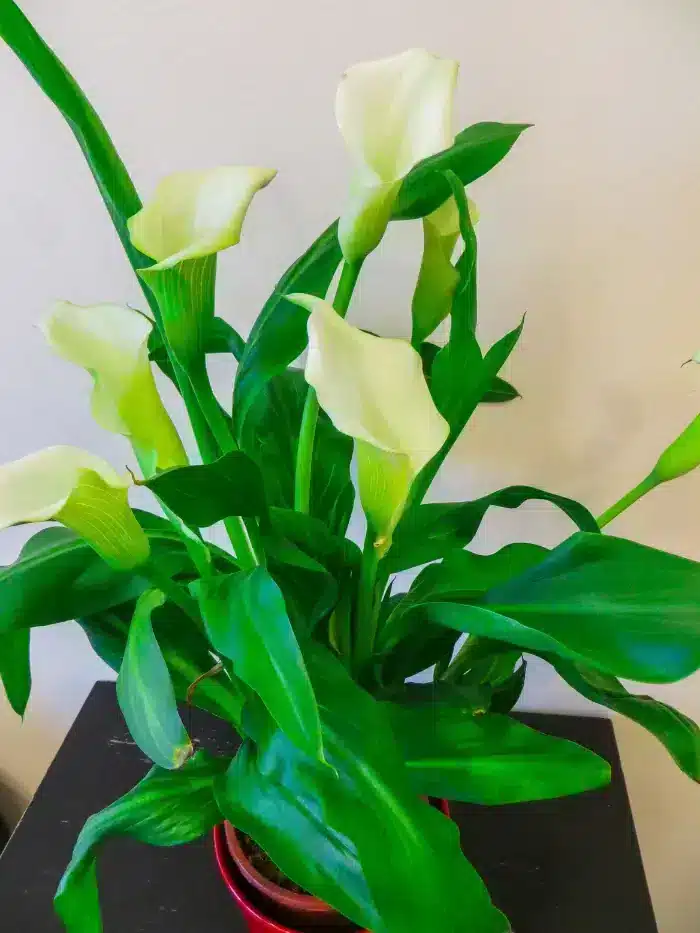Calla Lily Drooping: 8 Reasons and Fixes
Calla lilies (Zantedeschia sp.) are well known for their stunning blossoms, but it can be disappointing when their leaves and flowers begin to droop. Drooping is typically linked to water problems, but other issues can also cause the wilt.
Calla lilies droop due to underwatering, overwatering, too much sunlight, root rot disease, compacted soil, and repotting stress. The main fix is to repot your calla lily in a well-drained potting mix and place it under partial shade. Water the plant only when the top inch of soil is dry to allow it to recover.

Before you apply a fix, diagnose the plant to determine the cause of drooping and treat it as a specific problem. I’ve explained
Reasons and fixes for drooping calla lily
Calla lilies are easy to care for but can be sensitive to environmental changes. In my experience, changes in temperature, humidity, watering patterns, and top-heaviness easily cause these flowers to droop and wilt.
Here are the most common reasons that cause drooping in calla lilies.
1. Underwatering
Calla lilies prefer moist soil to thrive. Underwatering, in this case, will make the soil dry out.
The dry soil will dehydrate the calla lilies’ roots, reducing their ability to take in enough nutrients to nourish them. Hence, the plant’s stem will weaken, and the leaves will lose their turgidity. Eventually, they will wilt and then sag due to lack of water.
Prolonged lack of water affects the hydrostatic pressure or what’s called turgor pressure in the plant, leaving the leaves, flowers and stems to wilt and droop.
Underwatering can also cause the soil to become compact and reduce the chances of water reaching the roots when you water them. Hence, the plant becomes dehydrated and starts to droop.
Best fix
Water the calla deeply until the soil is moist but not soggy. Place the plant under partial shade to allow it to absorb the water and restore its normal turgidity. Slowly, you’ll notice it revive from drooping and attain its normal appearance.
At this point, resume a healthy calla lily watering routine, which should be once a week or a little more frequently during the hot summer months.
2. Overwatering
When you overwater your plant, the roots get waterlogged, preventing it from effectively taking in water and minerals.
Eventually, the roots of your calla lily will start to rot, making it difficult for them to support the plant. The plant’s stem will sag, and the leaves will start drooping due to its inability to draw in water that’s required for support.

Pro tip: Plants like calla lilies and peace lilies droop even when overwatered, and giving them an extra drench will only kill them. You want to ensure you check the soil for moisture to determine if the problem is the plant sitting in excess water before treating it.
Limiting the amount of water you give your Calla Lilies and only water them when the top inch of soil is dry is essential. It is also essential to ensure that the soil drains adequately to prevent water from stagnating around the roots.
Best fix
First, check to ensure the drainage hole in the planter is not clogged and that it is working. Second, drain the excess water from the pot.
- If the pot didn’t have drainage holes, drill a few into it to allow the excess water to drain out.
- I have found succeeded by removing the root ball from the potting soil and wrapping it in old newspapers and toilet paper overnight to drain the excess water before repotting it.
When the calla lily recovers from overwatering, ensure you water it only when the top inch of the soil is dry. Water deeply once a week, allowing the soil to drain well in between. Avoid letting the plant sit in standing water to prevent root rot.
3. Extreme temperatures
Calla lily is a tropical plant and cannot survive in cold temperatures. Even the slightest amount of frost can cause the leaves to wilt and droop.
Despite the calla lily being a tropical plant that loves warm temperatures, high temperatures might also kill it. Extreme temperatures exceeding 75℉ cause the plant to lose more water than it takes in, making it droop.
Furthermore, sudden temperature changes can also cause calla lilies to droop. If you bring the plant indoors after exposing it to outdoor conditions during the onset of winter, it may take some time to adjust and might droop.
Best solution
Zantedeschia prefers daytime temperatures between 55℉ to 65℉ with slightly cooler night temperatures. Maintain indoor temperatures within this range to keep your calla lily happy and healthy.
4. Over-fertilizing
Fertilizing is good for plant growth, but excess nitrogen fertilizer often causes severe symptoms, including drooping, legginess or weak stems, and too much foliage.
Adding too much fertilizer to the soil leads to a saturation of fertilizer particles, interfering with mineral absorption and transport to the plant. The plant hence becomes unhealthy and starts to droop as it is unable to hold the weight of its leaves.
Best remedy
Start by reducing fertilizers (especially inorganic ones) and allow the plant to recover gradually. If you think you applied too much fertilizer, I recommend repotting in a new soil mix as soon as you can.
I prefer feeding my calla lilies organic food, so I recommend potting it with well-rotted compost or bone meal mixed into potting soil. If your plant is already established, you can give it a diluted fish emulsion twice weekly to encourage healthy growth.
5. Excessive sun exposure
Excessive sun exposure can harm calla lilies, causing drooping and other problems. Sunburn in calla lilies occurs when exposed to very bright direct sunlight for long periods.
The sunburned leaves get discolored and may begin to dry out and curl, giving the plant a wilted and drooping appearance.
Furthermore, excessive sun exposure can cause the soil to dry up fast, leading to dehydration. The plant will then wilt and droop as it strains to absorb water.
Best fix
Move the plant away from direct sunshine. Calla lilies can thrive in partial sunlight, but overexposure to sunlight can cause the plant to droop.
To revive your droopy calla lily, move it to a spot with partial shade, such as near a window with curtains or under a tree if you’re growing it in the garden.
6. Repotting shock
Limp calla lilies can also be caused by repotting shock. Your plant’s root system gets disturbed when you repot it, leading to shock. This might affect the plant’s ability to absorb water and nutrients, resulting in drooping.
In most cases, repotting stress causes the plant to shed some of its leaves, leading to less energy to support further development. As a result, the plant may grow weaker and more vulnerable to future stress and damage.
Best fix for repotting shock
If you recently repotted your calla lily, the best thing to do is allow it time to recover on its own. The symptoms of shock will go away on their own. However, ensure it is getting the best care in terms of moist soil and partial light/shade, but avoid fertilizing it at this point until it recovers.
7. Insufficient light
Calla lilies require bright, indirect light to thrive well. They can tolerate some direct sunshine. However, giving them shade is preferable to avoid overexposure and sunburn.
Since it is a positive phototropic plant, inadequate lighting can cause it to stretch or bend in search of sunlight. Intense stretching and bending will cause the stems to become elongated and unable to sustain the weight of the leaves. Hence, causing its leaves to droop.
Additionally, insufficient light reduces the rate of photosynthesis; hence the plant grows fewer leaves and stems, making it more prone to drooping. The few leaves may also get stunted since it does not make food and bloom less frequently than usual.
To fix this problem, move your calla lily to a place where it will receive partial sunlight as I’ve explained above.
8. Pests and Diseases

Many pests can affect calla lilies, including spider mites, aphids, and thrips that feast on their leaves and stems, sucking their sup. This can cause the leaves to turn yellow and wilt, causing them to droop eventually.
On the other hand, diseases such as root decay, powdery mildew, soft rot, and bacterial leaf spot weaken the plant, causing the leaves and stem to weaken and droop.
Also, drooping calla lilies can be the after-effects of fungal diseases like anthracnose, which attacks the rhizome and stems of the plant, gradually leading to weak stems.
Best treatment
Treat root rot and repot the calla lily, as it is the best remedy when the cause of drooping and yellowing is root rot disease.
Here is how to repot your calla lily plant carefully:
- Get a larger container with drainage holes, fresh potting soil, and sterilized pruning shears.
- Remove the plant from the pot gently to avoid harming the roots. Then wash the roots with running water.
- Trim away any mushy roots using the pruning shears.
- Fill the container with fresh well, draining potting soil, then place your calla lily inside.
- After that, water the plant thoroughly and place it in an area that receives bright, indirect light.
Conclusion
Calla lilies are beautiful indoor plants that can thrive with proper care. If you see drooping leaves, check for issues like over/under watering, direct sunlight, or root rot and take steps to revive the plant. With proper care, you can enjoy their beauty for years.



![Are Calla Lilies Annuals or Perennials? [EXPLAINED]](https://gardenine.com/wp-content/uploads/2020/08/Are-calla-lilies-annuals-or-perennials.webp)